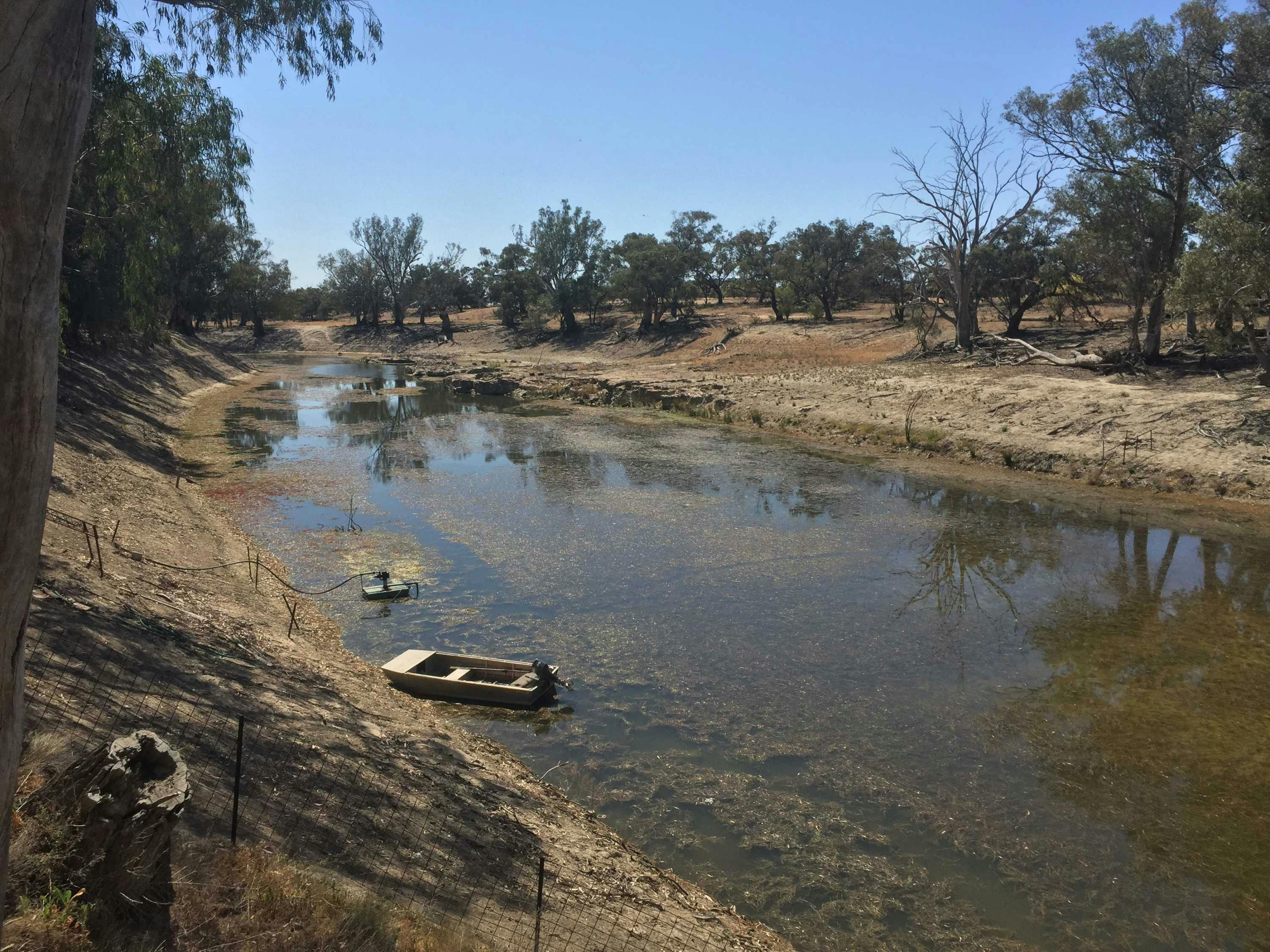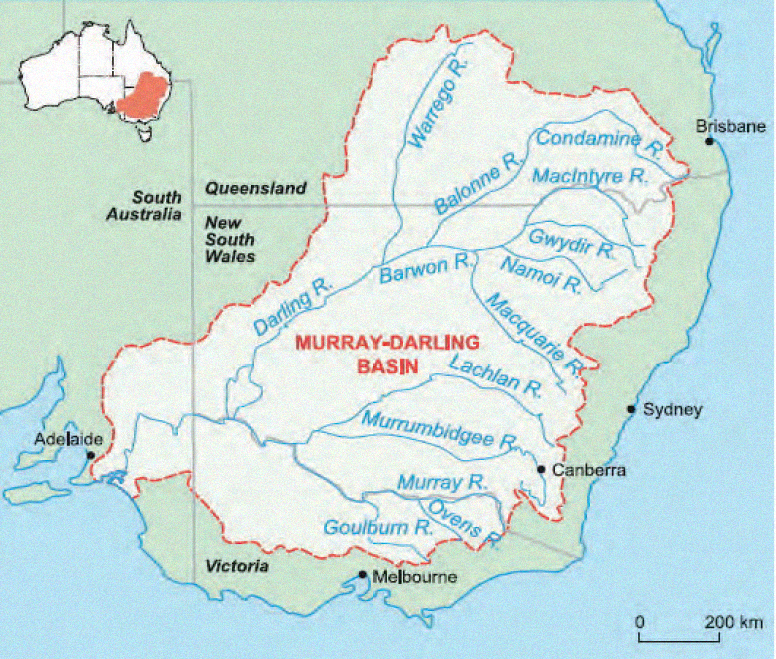How capitalism is killing the Murray-Darling Basin

It’s difficult to overstate the ecological and social significance of the Murray-Darling Basin, the region containing six of Australia’s seven longest rivers. For tens of thousands of years, this river system has supported unique, complex ecosystems and human life in what—excepting Antarctica—is Earth’s driest continent. The basin spans about one-seventh of the continent’s landmass (just over 1 million square kilometres), and supplies a third of Australia's food.
The basin, however, is in a deep crisis. Parts of the Darling and other major rivers are running completely dry with increasing frequency, indicating an alarming trajectory: the Murray-Darling Basin is dying. Or more accurately, it is being killed. Capitalism is killing the rivers, in more ways than one.
Australia's water crisis is connected to capitalism’s broader environmental crisis of climate change. For the Murray-Darling Basin, climate change means reduced rainfall and intensified drought. Recent data from the CSIRO shows the overwhelming scale of this problem. Its modelling indicates that, during the 20th century, the basin’s water inflow averaged 9,407 gigalitres per annum. For the last 20 years, however, annual inflows have averaged 4,820 gigalitres. “It is going to get worse”, reported research leader Francis Chiew. “There will still be wet years, but you will get more and more dry years and more and more drought.”

This should be seen for the environmental crime that it is. Successive Australian governments—whether the Coalition or Labor—have not only failed to reduce significantly Australia’s emissions, but they’ve actively supported the continued expansion of the fossil fuel industry. Australia’s per capita emissions rank second out of 37 OECD member states, and the emissions from our massive fossil fuel exports are third in the world, behind only Russia and Saudi Arabia. Our government might as well have been robbing the inland sky of rain clouds.
A drier climate isn’t the only thing draining the once powerful Murray and Darling rivers. The basin is also subject to direct environmental pillage and vandalism at the hands of major agribusinesses.
Water theft is rife under capitalism. An international study—“Grand theft water and the calculus of compliance”—published last year in Nature Sustainability, found that “uncertain supply and growing demand are driving higher water theft, particularly by agricultural users who account for approximately 70 percent of global use”. The study estimates that a whopping 30 to 50 percent of the global water supply is stolen each year, largely by agribusiness and farmers. Authorities rarely even register, let alone punish, this crime.
The agricultural corporations that dominate the Murray-Darling Basin are among the world’s worst water thieves. Since 2012, more than 2 trillion litres of water have gone missing. According to an investigation published in 2020 by the Wentworth Group of Concerned Scientists, which measured water flow at sites across the basin, the rivers are missing 20 percent of the water expected under the federal government's Murray-Darling Basin Plan.
How does four and a half Sydney Harbours’ worth of water simply disappear? The answer can be found in the megafarms irrigated by the rivers. Irrigators—producing rice, citrus, nuts and above all cotton—have mastered the disappearing act.
Travelling along the Barwon, it doesn’t take long to encounter large pumps connecting the river to vast agricultural properties. These are the machines pulling billions of litres of water from the river. Their suction can be powerful enough that, reportedly, the river has been seen to flow in the wrong direction.
Over-extraction is rife. Irrigators’ crudest method is simply pumping during bans, while river flow is dangerously low, and hoping that no-one notices. Even in normal periods, upstream irrigators are notorious for pumping more water than they are legally entitled to, building vast private dams to store their loot. Meanwhile Broken Hill and other downstream areas face the risk of severe water shortage.
This sort of theft can be hidden by another common practice, revealed by Four Corners in 2017: irrigators tampering with water meters. This was exemplified when investigators visited the Miralwyn cotton farm in 2015, finding a discrepancy between the count on the water meters and the volume of water stored at the property. Upon looking inside the meters, they found cables unplugged.
In some parts of the basin tampering is hardly necessary, as there is no adequate metering in the first place. Many big irrigators have been getting by with old or broken technology, ignoring directives to install tamper-proof meters and, in the case of faulty meters, neglecting to keep logs of the volume of water pumped.
Recent data has confirmed that not much has changed since the Four Corners investigation sparked outrage four years ago. In fact, the majority of New South Wales irrigators are defying water law. Of 1,100 licences surveyed by the Natural Resources Access Regulator, more than 700 had refused to install approved, accurate meters.
Irrigators and graziers have another murky method of stealing water: the harvesting of water. not directly from rivers, but from floodplains. Decent rains cause the Macquarie River to spill over into the vast Macquarie Marshes, an internationally significant breeding ground for waterbirds. The overflow into these wetlands is eventually supposed to drain back into the river system. But businesses can manipulate the water’s movement, and in ways more insidious than pumping. The flat landscape allows relatively slight structures—roads, inclines, channels and levee banks—to redirect much of the water onto farmland for absorption or damming.
Authorities have shown little interest in measuring floodplain harvesting. As river ecologist Richard Kingsford told the ABC, “There are very few places where we have an accurate estimate of how much water is being taken from the floodplain”.
Water theft occasionally results in penalties for irrigators, but the government and water authorities have in effect been complicit. The Murray-Darling Basin Plan, initiated in 2012 and overseen by the Murray-Darling Basin Authority (MDBA), has been a colossal sham. Fundamentally business-focussed, its disinterest in genuine environmental outcomes was evident from the start with the MDBA’s refusal to factor climate change impacts into its planning. For a decade, the MDBA regime has enriched a few major cotton growers while allowing the rivers to dwindle.
A striking example is the cooperation between the government and the agribusiness Webster Limited, chaired by the well-connected Chris Corrigan of waterfront union-busting fame. Webster was handed $41 million by the government under the water infrastructure scheme, helping the company pay for a $78 million expansion of its nut and cotton empire in the Murrumbidgee Valley.
More than $4 billion in such funds has been granted to irrigators under the scheme, which constitutes a major part of the $13 billion Basin Plan. The MDBA’s pretence is that farms, in return for their water rights, will build water-saving infrastructure to the benefit of the environment. In reality, the funds only help boost irrigation. Webster has built several new monster dams, trapping water that would previously have flowed past its farms and through the basin. Webster’s investors, meanwhile, have reaped millions in profit.
Cronyism, corruption and outright theft are draining the rivers dry. Mild reforms or personnel changes won’t be enough to halt the basin’s decline.
Perhaps the main, underlying, factor driving water crimes in the basin is a structural one: the growing of extremely water-intensive crops like cotton, rice and almonds, in areas that are too dry for them. Companies producing cotton are extending their huge plantations outwards from the rivers—ever further into more arid parts of northern New South Wales and southern Queensland—and pumping more water to make it possible.
Anyone taking a medium to long-term view will recognise that these commodities simply shouldn’t be grown in these regions. But capitalists take a short-term view. The most important thing to them is to grow whatever crop is most lucrative, take unused land however arid, seize whatever water still exists and deliver maximum dividends to shareholders.
Rivers and soils have their own laws and limits as to what they can sustain. But when an economic system’s defining goal is the endless accumulation of profits, the bounds of nature will never be respected. Capitalism is a juggernaut which knows no law apart from its drive to exponential self-expansion. That rice crops are naturally more suitable to certain Asian climates is not of concern to a firm’s balance sheets—if it can be sold for a sufficient profit, rice will be farmed along the Murray.
Capitalism’s thirst cannot be quenched. If we don't fight for a different system, the rivers that sustain life on this continent could one day run dry for good.